Link building is one of the oldest and most effective SEO tactics. It’s also one of the most productive ways to grow organic search traffic.
Oddly, though, link building can actually harm your traffic, too.
Historically, links were how Google figured out which websites were good: a link was a recommendation, so websites with more links ranked higher. Google let the web decide how good each page was. Since then, Google updates have largely been about getting ahead of efforts to game this process by acquiring unearned links.
We’re now at a point where only very white hat link building methods still reliably work. It’s basically impossible to beg, borrow, steal, or buy links effectively. All you can do is earn them. But there are still smart ways to do that. And some of them allow you to piggyback on your competitors’ successes at the same time!
1. Guest Blogging
Google has warned against guest posting and put a lot of people off. But high quality, targeted guest posts are different from the mass-produced, low-value posts that were a staple of many SEO strategies a few years ago. Done right, guest blogging can be an effective link building tool.
The first thing you need to do is get the best guest blog spot you can. Identify sites that might take your guest post by scoping out your competitors’ guest posts. For an example here, I’ll use Neil Patel, which means we’ll get a lot of search results.
Start with an advanced Google search, using the author’s name in quotation marks and the words “guest post” also in quotation marks. Include the author’s home domain with a minus sign in front so all those results will be excluded.
“Neil patel” + “guest post” -neilpatel.com -quicksprout.com -kissmetrics.com

The HubSpot and Forbes results are actually articles by Neil Patel; the others mention him in pieces about guest posting. Since Patel’s name is everywhere online, it might help to narrow this down a little. So an alternative is to search within the URL and identify the author as the author, so you don’t get anything that’s about them or just mentions them.
Do that by searching for the author’s name in quotation marks and using the search parameter in URL: author.

This is better. There are more usable results. But we can use Ahrefs’ Content Explorer to identify content written by a certain author, too. Enter the author’s name as a search term in this form:
Author: “Author’s Name”
Make sure there’s no space between the colon and the first quotation mark.
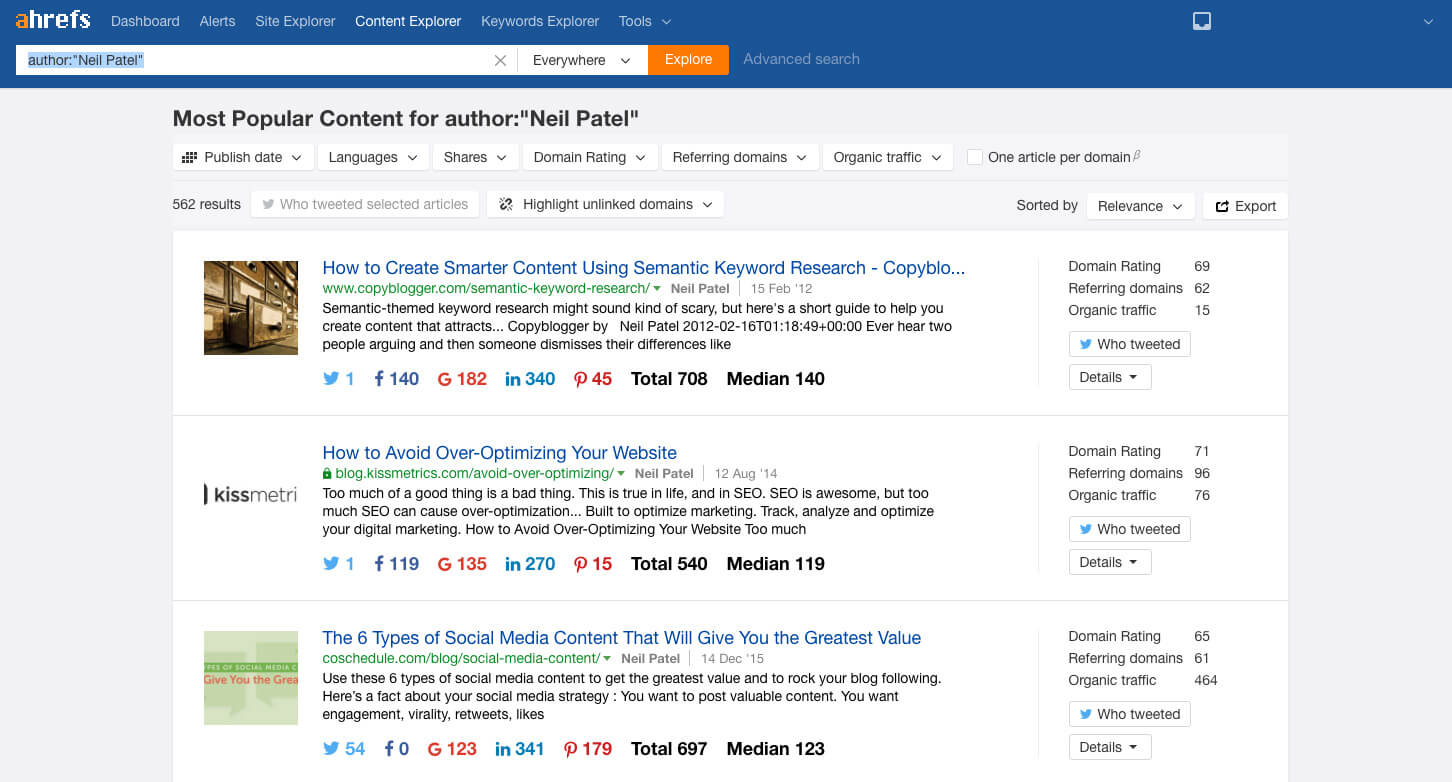
This is much better than Google. Not only are we seeing more of what we’re looking for, but we have sharing and backlink data right there on the sidebar.
If your competitor has already been featured on a site, there’s a solid chance the same site will take you, too. Now that you’ve tracked down some sites, pitch to them via their “write for us” form or email the editor.
Next, you need to get the best guest post link(s) you can. Guest blogging works to build links because you can put links to your website in your post, and usually in your author bio.
Make sure the links are contextual, if you can, rather than hidden in author bios where they are less likely to be clicked and where Google doesn’t love them as much. The best way to get a natural contextual link is to treat that resource exactly as you would if it was someone else’s. Just put it in naturally, and use anchor text that refers to its relevance, not to your site. And be generous. In the top search result above, Patel links out to Quicksprout once, and to Moz, Copyblogger, and a bunch of other places as well.
2. Public Relations
Public relations in the context of link building simply means using the same methods to get backlinks that you might use to get press.
If you would like to be a source, sign up to HelpaReporter.com, and they’ll tell you when they need someone with your skills for an interview.
Also, consider classic PR moves like press releases. Bloggers and journalists hoover up information, so if anything has happened – you have a new integration, client, product, feature – make it easy to find. Then you’re likely to be linked to in any article that covers the subject.
Where most people get press releases wrong is overuse of anchor text links. That’s one of the factors most likely to trigger a Penguin penalty. Instead, use your press release to field a variety of anchors linking to your site.
Additionally, press releases can still be added to directories and databases, making them an even better SEO tool.
Even when you do get mentioned, though, there’s no actual guarantee that the people referencing you will give you a link. Sometimes things slip through the net. When that happens, it can be worthwhile to reach out and remind them that you’d like to be linked to.
You can track mentions in Ahrefs. Go to Alerts > Mentions > Add Alert > Search Query > Daily > Add.
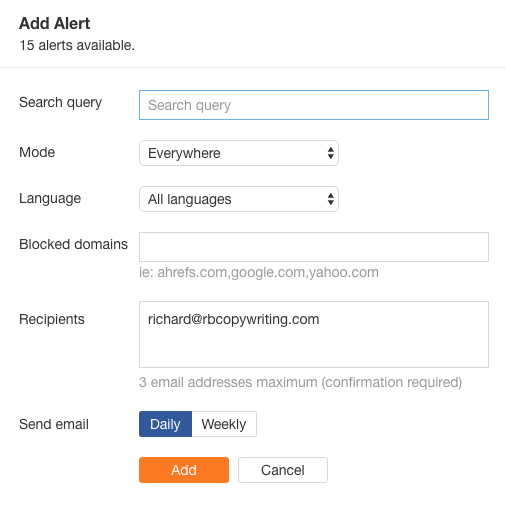
You can track your competitors the same way.
3. Broken Link Building
Even good, well-maintained websites suffer from “link rot.” Links lead to a location on the internet, but since websites move their content around, eventually, some links will lead to empty locations. Users arrive looking for a resource and find a vacant lot.
Broken link building fixes this and gets you links. It relies on finding broken links, identifying the content they refer to, and then offering the referring site the chance to refer out to some new, unbroken content – yours.
Everyone wins: website visitors see more up-to-date, useful content and fewer 404s; sites don’t have a whole bunch of broken links, and you get a high-quality backlink. For marketers, this is an effective way to get two birds with one stone: you get a blog post built around the right keywords, and, unlike a guest post, you get to keep it. So if anyone uses it as a resource, those links come straight back to you. But you get link juice up front, too.
How do you do it?
Start by identifying a site that you’d like a backlink from. If you have keywords figured out, search for them and identify sites that rank for them. Then check out those sites in Ahrefs and identify a broken link.
Use the Broken function in Site Explorer to identify backlinks that aren’t working. Let’s look at Copyblogger, a copywriting blog. Remember to check under outgoing links or you’ll get broken backlinks that lead to Copyblogger, not from it.
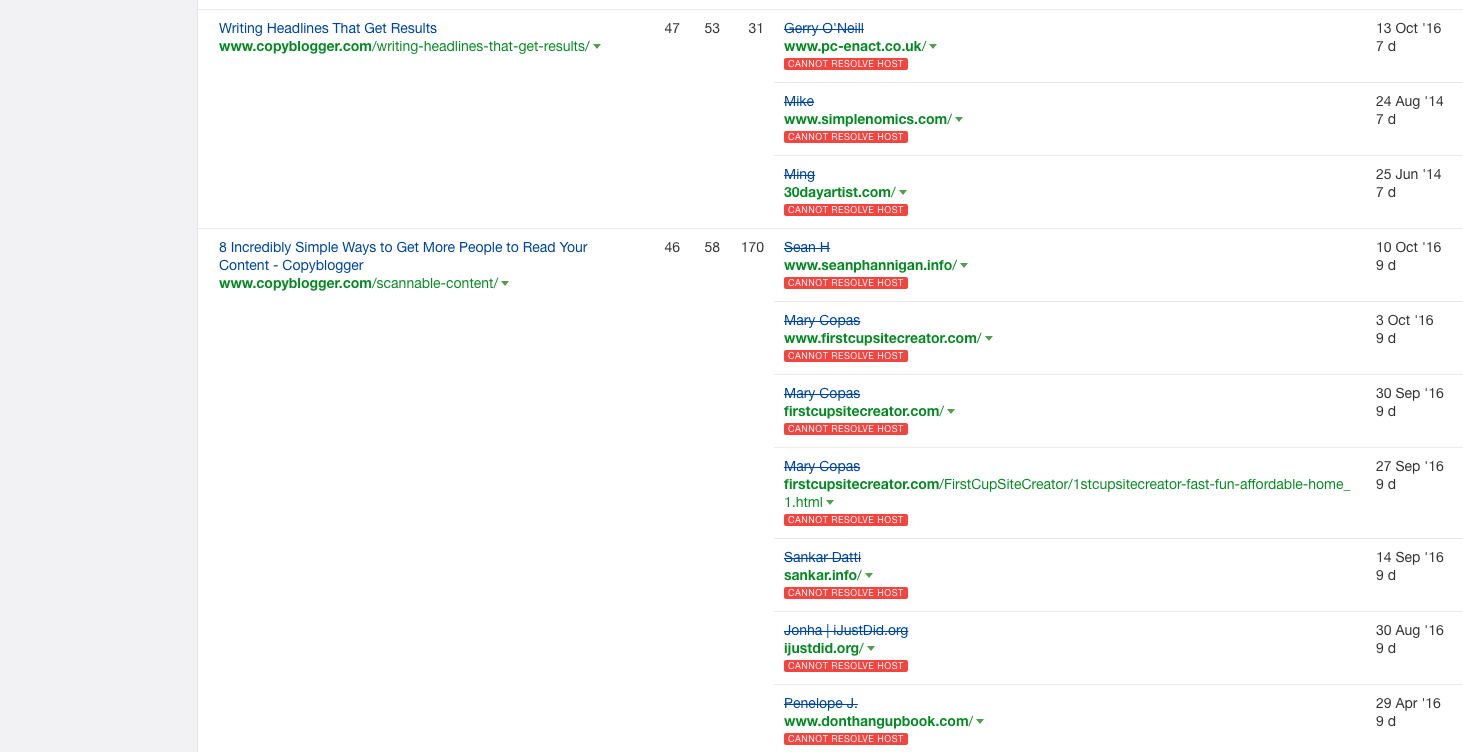
Make sure they’re do-follow links, which should link to useful content. Select Dofollow from the drop-down under Broken Links, and you get a very different view.
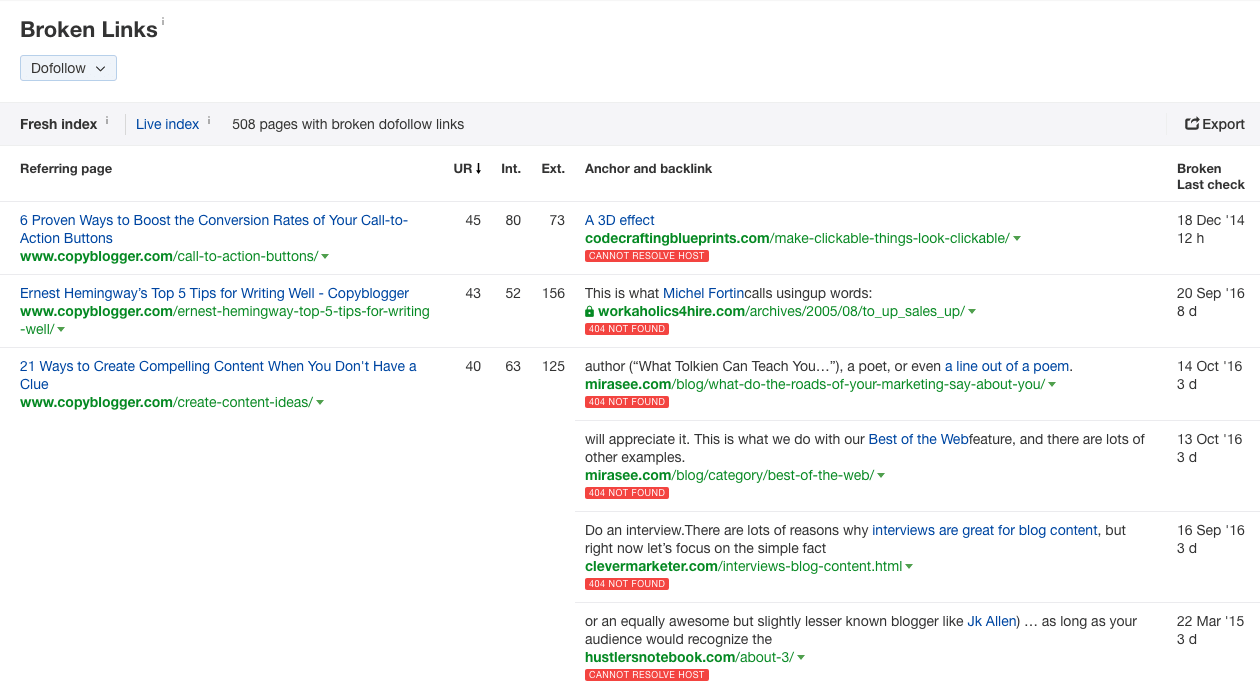
Having identified a broken link that looks like its subject is in your wheelhouse, follow it. You should see a 404 on the site’s domain. I followed the third dead link for 21 Ways to Create Compelling Content When You Don’t Have a Clue. The anchor text gives me a pretty good idea of what the subject will be: “why interviews are great for blog content.” The URL, http://clevermarketer.com/interviews-blog-content.html, tells me the same story. And it’s a 404.

Now it’s time to check out what the content was originally about, in order to craft something that replaces it and surpasses it.
Just because the content is not there now doesn’t mean we can’t see it. The internet comes with a free time machine, located at archive.org, which will let you search for what was located at a given URL in the past.

Simply enter the URL and you’ll see its history.
Check out the graph below:
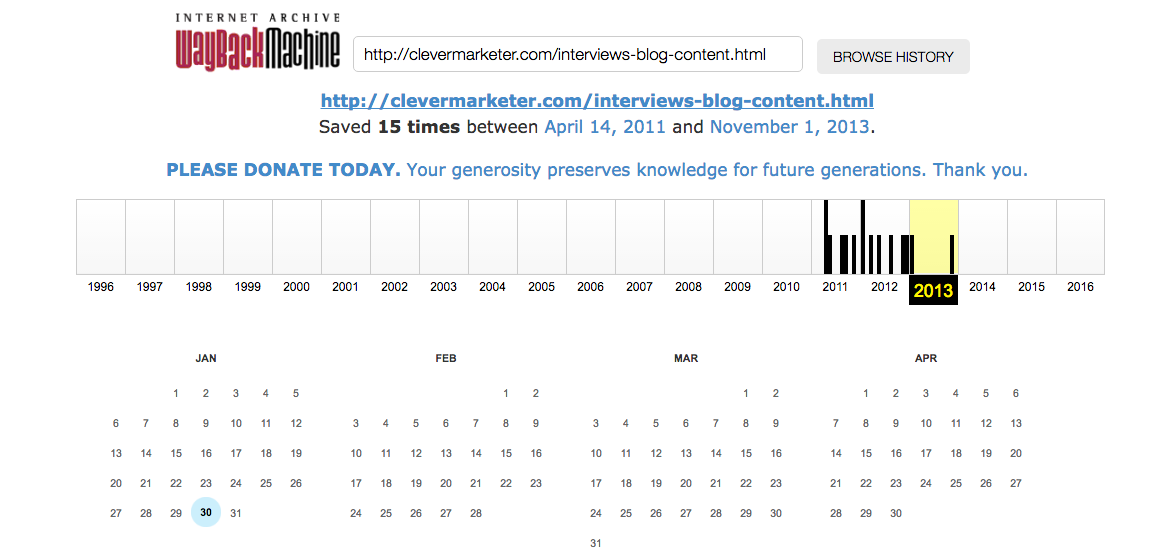
It looks like the post went up in 2011 and stopped working in 2013.
So we look in 2013, select one of the crawl dates highlighted in blue on the calendar (such as January 30 above), and we can see the original article:
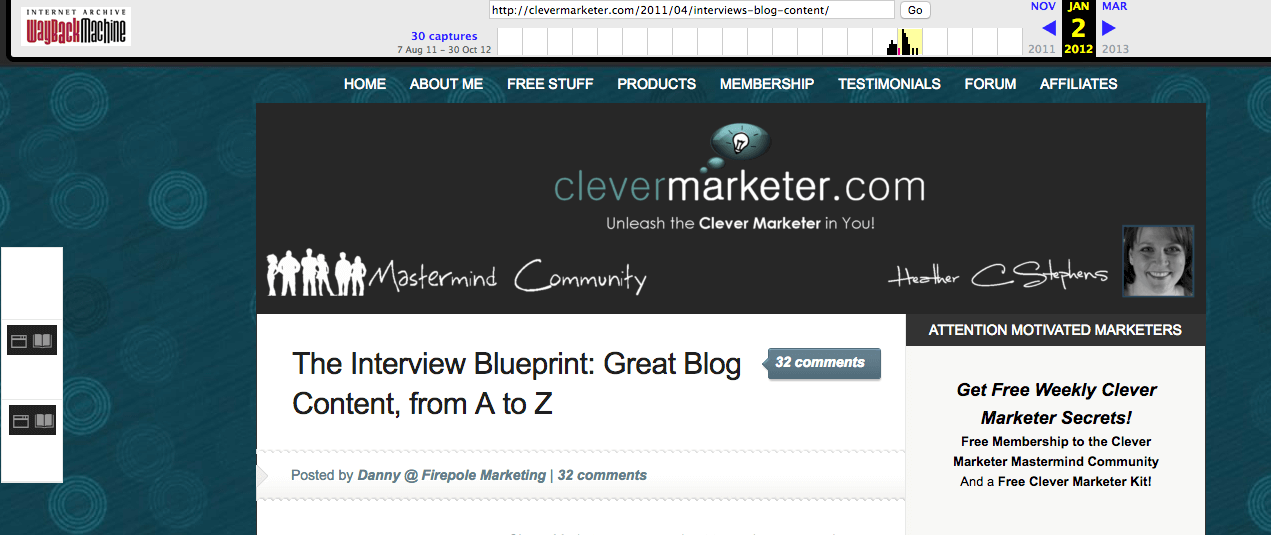
(This can take a while, so be patient.)
Now we have everything we need to write a better, more comprehensive, more detailed version of the original, one that’s right up to date.
Write the content and post it to your own blog. Then contact the website and tell them:
Hey, you have a broken link! I just wrote a piece of content that would fit with the link. Do you want to change the destination of the link so it links out to my content?
If this sounds a little familiar, that could be because it’s kind of like…
4. Skyscraper!
The brainchild of Brian Dean, skyscraping means finding content in your space that’s already awesome, and then out-awesome it. A simplistic way to do this might be to think, “Hmmm, 101 Ways to Improve Your Email Marketing is doing incredibly well. I’ll do 1,001 Ways and clean up!”
It might work. Or you might create something that’s bigger without being better. More points, more words, and more pictures don't always mean more value for the user. Instead, look at the content you’re skyscraping and ask yourself:
Which questions go unanswered?
Which instructions are hard to follow?
Who isn’t getting served here?
Shoot for quality, even though it’s the toughest thing to quantify, and you’re more likely to come out ahead.
If you have a specific competitor in mind, you can start skyscraping by using Site Explorer in Ahrefs to look for pieces in your niche that are doing particularly well. We’ll use Copyblogger again.
Enter the domain and select Site Explorer > Pages > Best by Links.

Many of these won’t work. They reference Copyblogger, or they’re generic, or there’s not much to be done with them. But keep scrolling down, and you’ll see some with potential.

One of these could be a skyscraper candidate. I’m tempted by item #49, How to Write Interesting Content for a “Boring” Topic. I drop the URL for that page into Site Explorer and select URL:
See search data…

As well as backlink data including referring domains…
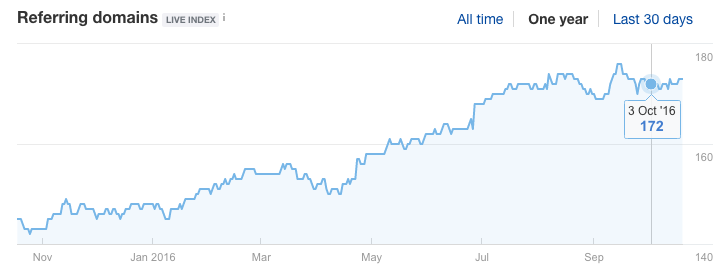
And anchor clouds.
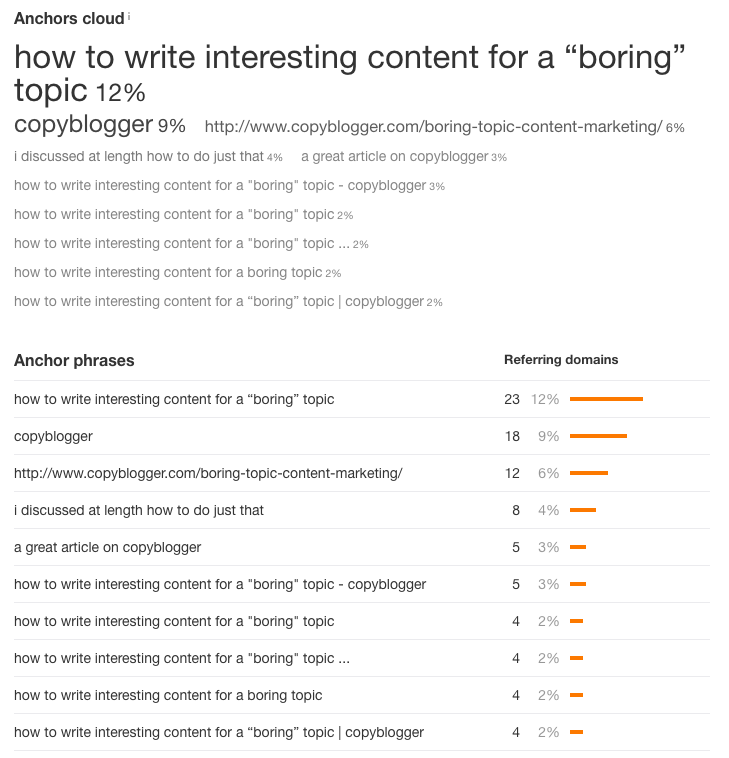
Once you have identified the page you want to a skyscraper and have created the content that outdoes the original, go back to Ahrefs and check out the referring domains for the original piece of content.
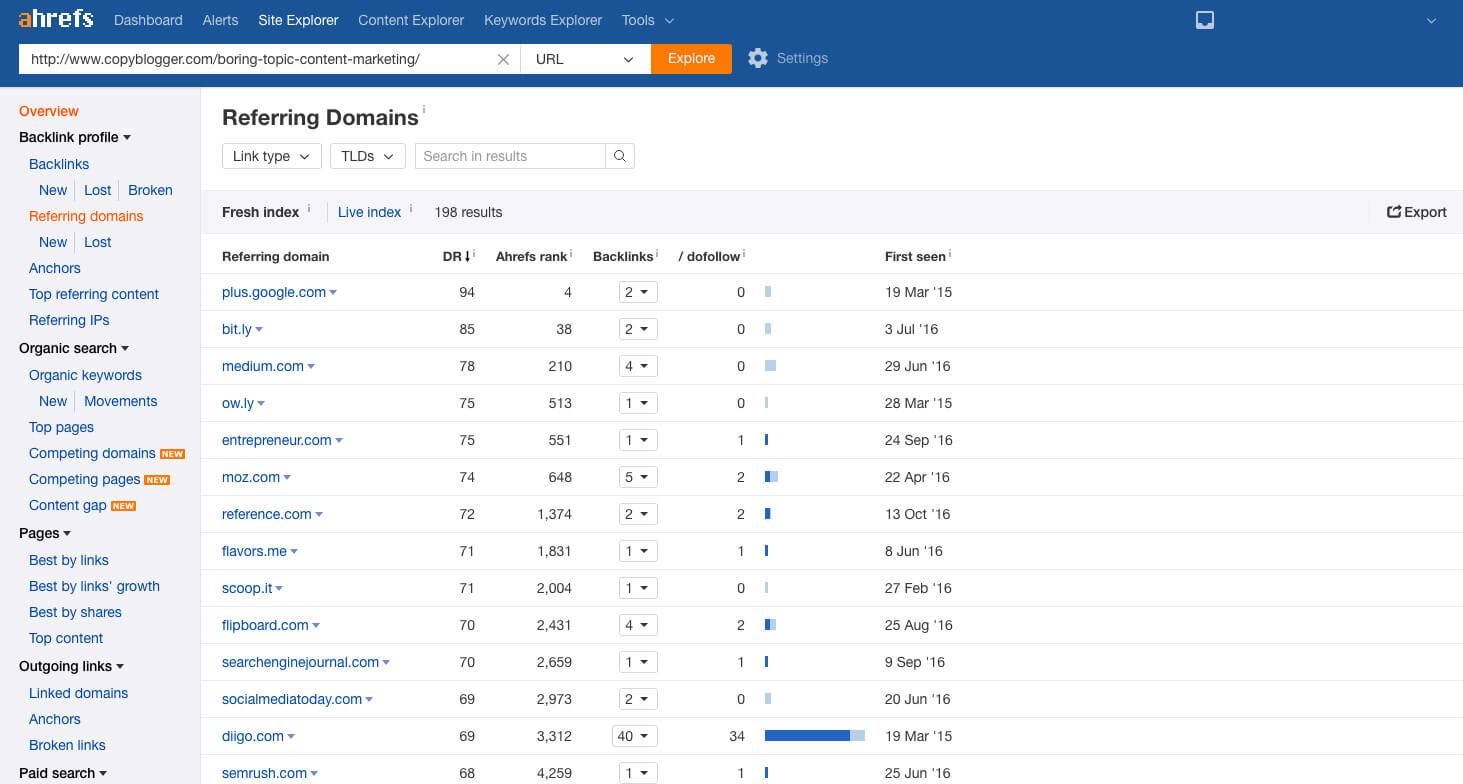
Find their backlinks – Moz.com, Entrepreneur.com, and SearchEngineJournal.com are on this list – and then contact those sites and offer them your new, improved content to link to instead.
5. Resource Links
Rather than linking to your blog post or a page on your website, resource links come back to your solid research or collected knowledge that everyone else needs to know.
How often do you think people link back to Content Marketing Institute’s B2B Content Marketing 2016 report?

That’s 1,516 unique domains linking to that one piece of content.
The key is to create resources that are useful to people in your space so they will link back to them when they use them in blog posts or other content. It doesn’t have to be original research. It can be a compendium of information from different places, gathered together, and presented with one group of people’s needs in mind.
You can build resources by using the same methods you’d use to steal a competitor’s traffic and links: find out what people in your space want to know by identifying the content they’re consuming, and then address that knowledge gap.
6. Find Competitors’ Backlinks and “Steal” Them
If a site will link to a competitor, it will probably link to you, too. Start by identifying the top ten sites for each keyword you want to rank for. Do a Google search and pick the top ten domains.
Suppose we want to rank for “Halloween email marketing.”
We’d get to see some truly appalling puns.

Sanity checks them for relevance, duplication, and, well, sanity. Make sure you remove any duds. For instance, GetResponse, Pure360, and Adestra all make sense. But Tax.ThomsonReuters.com? Probably not.
Take those domains over to Ahrefs and drop them into the Link Intersect tool.

Leave “But doesn’t link to” blank and click “Show link opportunities.”
This will show you a list of sites that link to all the domains you entered.
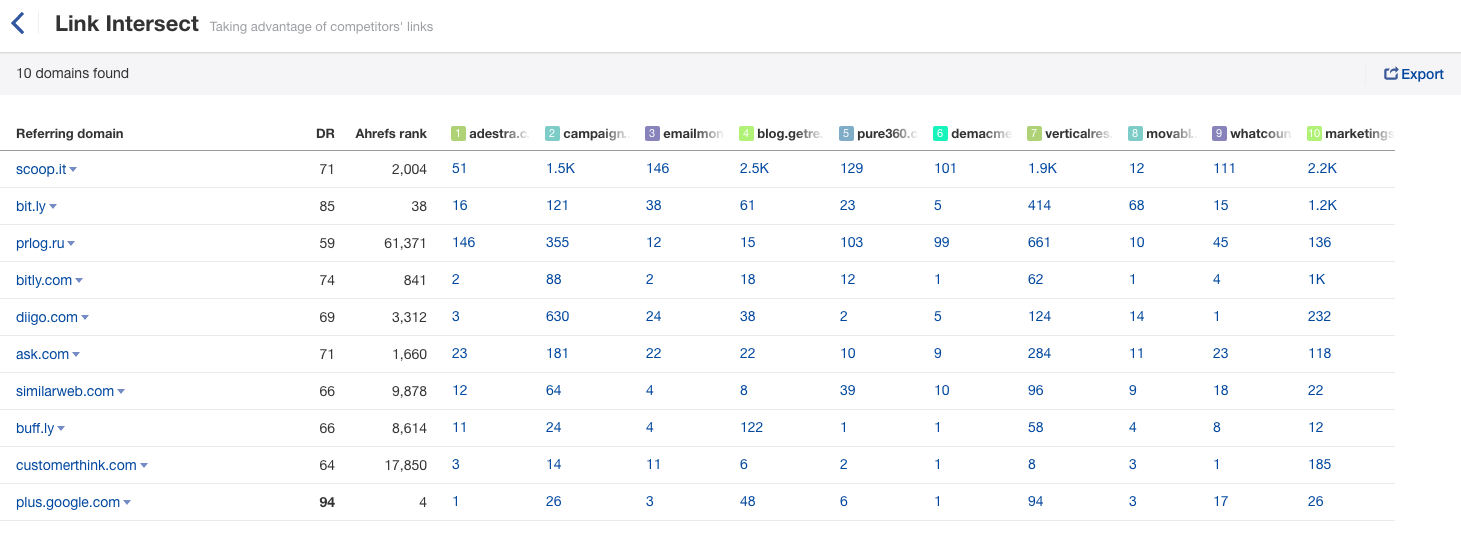
If you get a list like this, with generic stuff that’s not of much use to you, you need to shrink the number of domains a little.
Go back through and remove some of the less likely candidates, and then try again.

This time the results are much more useful. There are domains like TheEmailGuide.com, CustomerThink.com, and OnlineMarketingandSEO.com here. They would make good backlink targets.
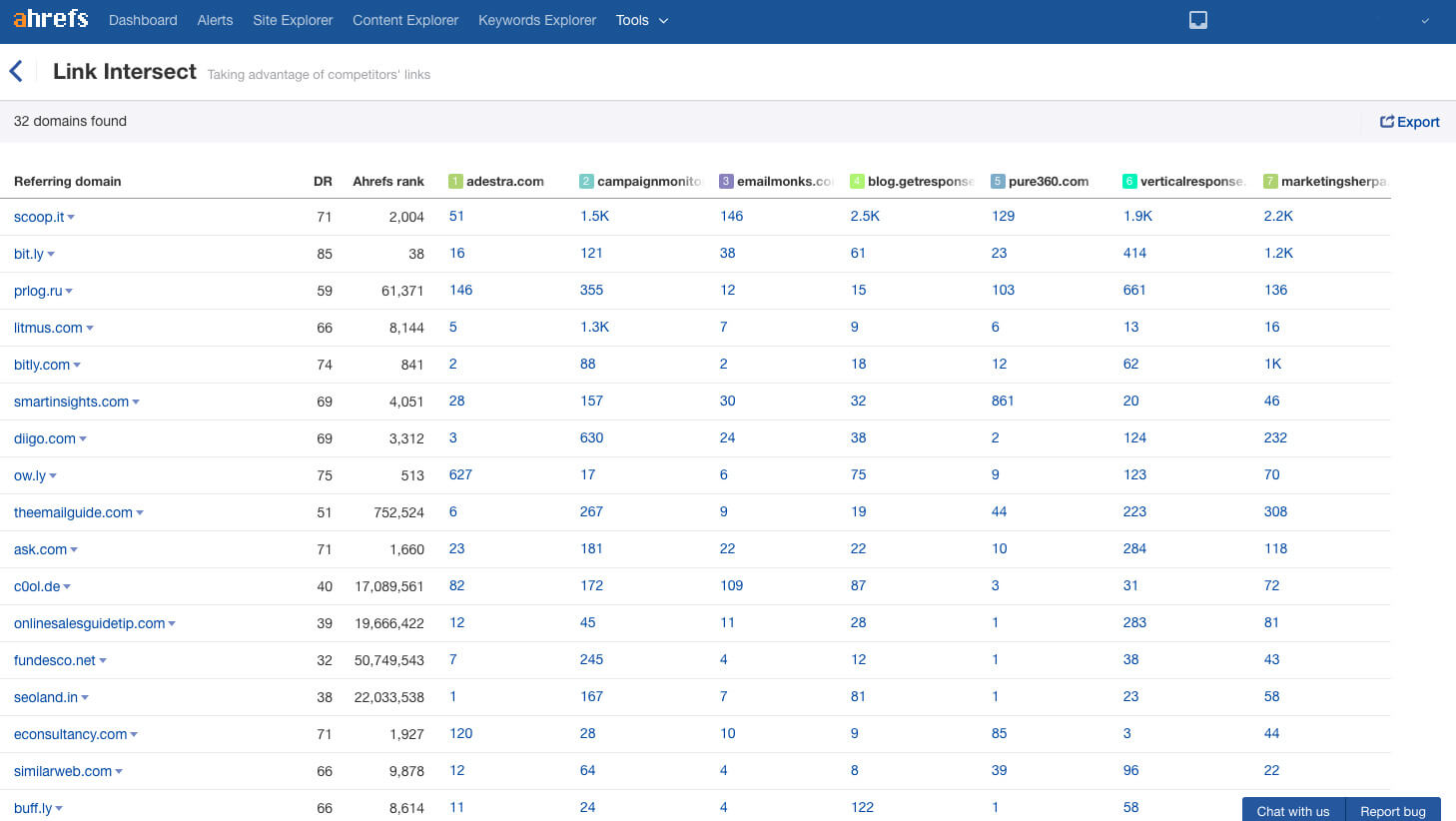
Alternatively, you can attempt to duplicate all your competitors’ backlink profiles. This approach involves a lot more work, but it’s a highly effective way to get a natural backlink profile that Google will love you for.
Start by collecting URLs, rather than domains, for each keyword. So if we went for “Halloween email marketing” again, we’d pick up the top ten organic results and take them over to Ahrefs. Then we’d drop them into Site Explorer and select Backlinks.
When I did this, several of the top search results had just one or two backlinks, but GetResponse’s infographic had 10 from unique domains.
The next step is to go through the links and figure out how that competitor acquired the link. You can copy the same method to get a link from that site yourself. If it was a guest post, that might be the way in. If they scored the link by adding the site to a directory, that could work, as long as it’s specific to your space and the quality is high.
Conclusion
Link building remains one of the most effective ways to rank better and drive more traffic that’s also more accurately targeted. As older methods become useless or actively harmful, and basic white hat techniques become all but indistinguishable from content marketing, the winning edge will go to marketers who know how to implement advanced link building techniques that tie their domain to the right sites.
Comments
Post a Comment